An Improved SAMP Algorithm for Sparse Channel Estimation in OFDM System
Abstract
1. Introduction
2. System Model
2.1. OFDM Communication System
2.2. OFDM Channel Estimation Model Based on CS Theory
3. The Proposed Improved SAMP Algorithm
3.1. The Improved SAMP Algorithm
3.1.1. Denoising Processing
3.1.2. Weak Selection Strategy
3.1.3. The Double Threshold Judgment
4. Simulation and Experimental Results
5. Conclusions
Author Contributions
Funding
Institutional Review Board Statement
Informed Consent Statement
Data Availability Statement
Conflicts of Interest
References
- Uwaechia, A.N.; Mahyuddin, N.M. A Review on Sparse Channel Estimation in OFDM System Using Compressed Sensing. IETE Tech. Rev. 2017, 34, 514–531. [Google Scholar] [CrossRef]
- Felipe, G.C.; Andrea, J.G. Compressed Sensing Channel Estimation for OFDM with Non-Gaussian Multipath Gains. IEEE Trans. Wirel. Commun. 2020, 19, 47–61. [Google Scholar]
- Zhao, X.J.; Yang, S.Y.; Zhang, A.H.; Li, X.Y. A Compressive Sensing Based Multi-user Detection Algorithm for SIMO-NOMA Systems. In Proceedings of the 2018 15th International Symposium on Wireless Communication System (ISWCS), Lisbon, Portugal, 28–31 August 2018. [Google Scholar]
- Wang, B.C.; Dai, L.L.; Zhang, Y. Dynamic Compressive Sensing-Based Multi-User Detection for Uplink Grant-Free NOMA. IEEE Commun. Lett. 2016, 10, 2320–2323. [Google Scholar] [CrossRef]
- Mohammadreza, R.; Robert, A.; Robin, C.; Utpal, K.D. Adaptive Millimeter-Wave Channel Estimation and Tracking. In Proceedings of the 2022 24th International Conference on Advanced Communication Technology (ICACT), Pyeongchang, Republic of Korea, 13–16 February 2022. [Google Scholar]
- Hamid, N.; Mohamed, E. New Constructions of Bernoulli and Gaussian Sensing Matrices for Compressive Sensing. In Proceedings of the 2017 International Conference on Wireless Networks and Mobile Communications (WINCOM), Rabat, Morocco, 1–4 November 2017. [Google Scholar]
- Donoho, D.L. Compressed sensing. IEEE Trans. Inf. Theory 2006, 52, 1289–1306. [Google Scholar] [CrossRef]
- Tropp, J.A.; Gilbert, A.C. Signal Recovery from Random Measurements via Orthogonal Matching Pursuit. IEEE Trans. Inf. Theory 2007, 53, 4655–4666. [Google Scholar] [CrossRef]
- Wang, J.; Seokbeop, K.; Byonghyo, S. Generalized Orthogonal Matching Pursuit. IEEE Trans. Signal Process. 2012, 60, 6202–6216. [Google Scholar] [CrossRef]
- Needell, D.; Vershynin, R. Uniform Uncertainty Principle and Signal Recovery via Regularized Orthogonal Matching Pursuit. Found. Comput. Math. 2009, 9, 317–334. [Google Scholar] [CrossRef]
- Donoho, D.L.; Tsaig, Y.; Drori, I.; Starck, J.L. Sparse Solution of Underdetermined Systems of Linear Equations by Stagewise Orthogonal Matching Pursuit. IEEE Trans. Inf. Theory 2012, 58, 1094–1121. [Google Scholar] [CrossRef]
- Thomas, B.; Mike, E.D. Stagewise Weak Gradient Pursuits. IEEE Trans. Signal Process. 2009, 57, 4333–4346. [Google Scholar]
- Thong, T.D.; Lu, G.; Nam, N.; Trac, D.T. Sparsity adaptive matching pursuit algorithm for practical compressed sensing. In Proceedings of the 2008 42nd Asilomar Conference on Signals, Systems and Computers, Pacific Grove, CA, USA, 26–29 October 2008. [Google Scholar]
- Ge, L.J.; Cheng, Y.T.; Xu, W.; Tong, J. Sparsity adaptive channel estimation based on compressed sensing for OFDM systems. J. Chin. Inst. Eng. 2017, 40, 146–148. [Google Scholar] [CrossRef]
- Wang, H.H.; Dou, S.Y.; Huang, Z.X. A channel estimation algorithm based on adaptive threshold and compressed sensing. Nat. Sci. 2022, 42, 23–29. [Google Scholar]
- Li, J.; Gao, Z.R.; Xiong, C.Y.; Zhou, C. Image compressive sensing recovery based on weighted structure group sparse representation. J. Commun. 2017, 38, 196–203. [Google Scholar]
- Wei, Y.B.; Lu, Z.Z.; Yuan, G.N.; Fang, Z.; Huang, Y. Sparsity Adaptive Matching Pursuit Detection Algorithm Based on Compressed Sensing for Radar Signals. Sensors 2017, 17, 1120. [Google Scholar] [CrossRef] [PubMed]
- Yuan, W.N.; Yan, Q. Channel estimation method based on compressive sensing for FBMC/OQAM system. J. Commun. 2019, 40, 98–104. [Google Scholar]
- Wang, B.; Ge, Y.F.; He, C.; Wu, Y.; Zhu, Z.Y. Study on communication channel estimation by improved SOMP based on distributed compressed sensing. Eurasip J. Wirel. Commun. Netw. 2019, 2019, 121. [Google Scholar] [CrossRef]
- Khan, N.K.; Reddy, G.R. Compressed Sensing Algorithms for SISO-OFDM Channel Estimation. In Proceedings of the 2020 International Conference on Emerging Trends in Information Technology and Engineering (IC-ETITE), Vellore, India, 24–25 February 2020. [Google Scholar]
- Jose, R.; Pavithran, G.; Aswathi, C. Sparse channel estimation in OFDM systems using compressed sensing techniques in a Bayesian framework. Comput. Electr. Eng. 2017, 61, 173–183. [Google Scholar] [CrossRef]
- Wang, K.; Wei, H.J.; He, W.; Gan, Z.C. Dynamic measurement for compressed sensing based channel estimation in OFDM systems. In Proceedings of the 2017 3rd IEEE International Conference on Computer and Communications (ICCC), Chengdu, China, 13–16 December 2017. [Google Scholar]
- Dai, Q.H.; Fu, C.J.; Ji, X.Y. Research on Compressed Sensing. Chin. J. Comput. 2011, 34, 425–434. [Google Scholar] [CrossRef]
- Olabiyi, O.; Alam, S.; Odejide, O.; Annamalai, A. Further Results on the Energy Detection of Unknown Deterministic Signals over Generalized Fading Channel. In Proceedings of the 2011 IEEE GLOBECOM Workshops (GC Wkshps), Houston, TX, USA, 5–9 December 2011. [Google Scholar]
- Gao, R.; Zhao, R.Z.; Hu, S.H. Variable Step Size Adaptive Matching Pursuit Algorithm for Image Reconstruction Based on Compressive Sensing. Acta Opt. Sin. 2010, 30, 1639–1644. [Google Scholar]

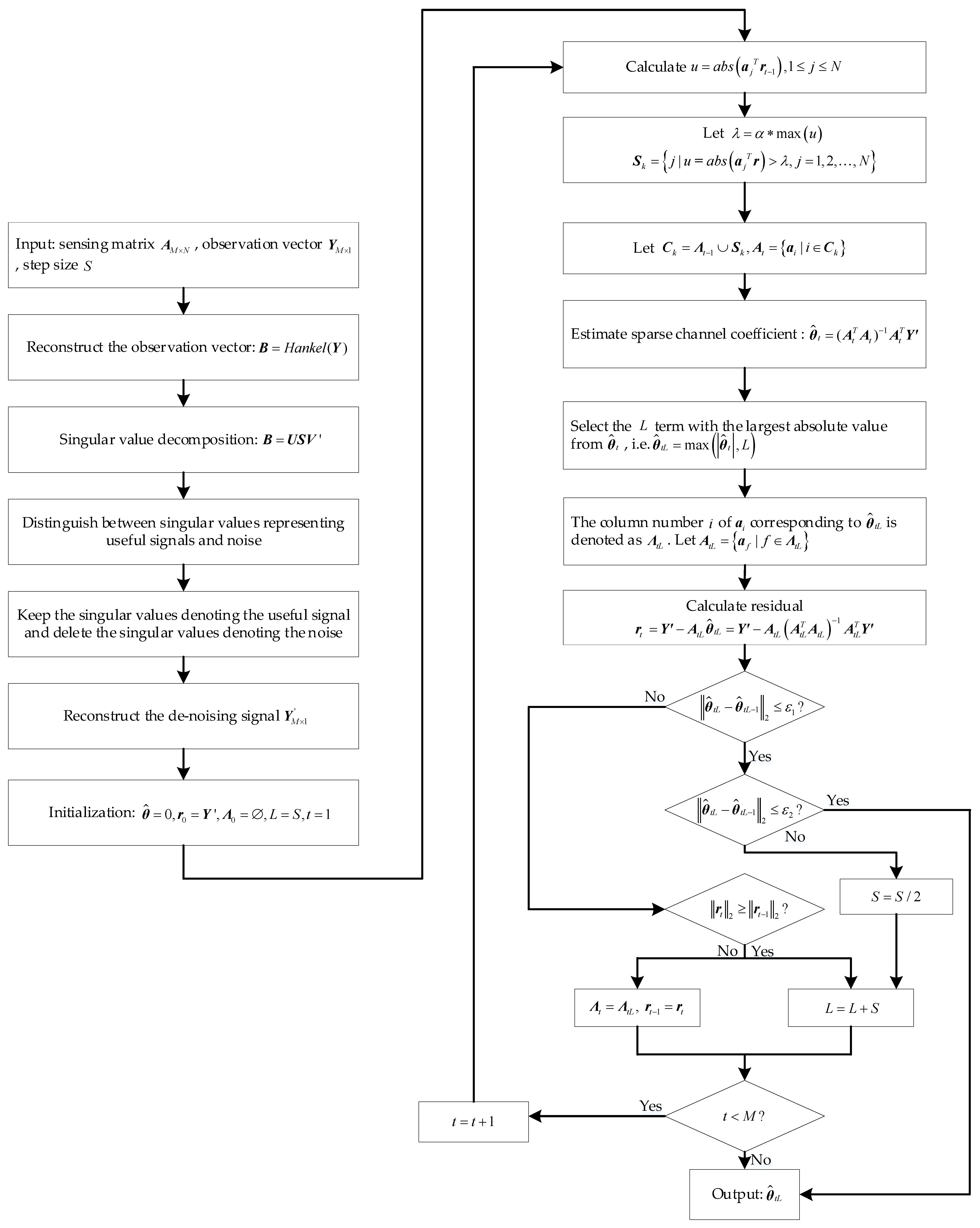
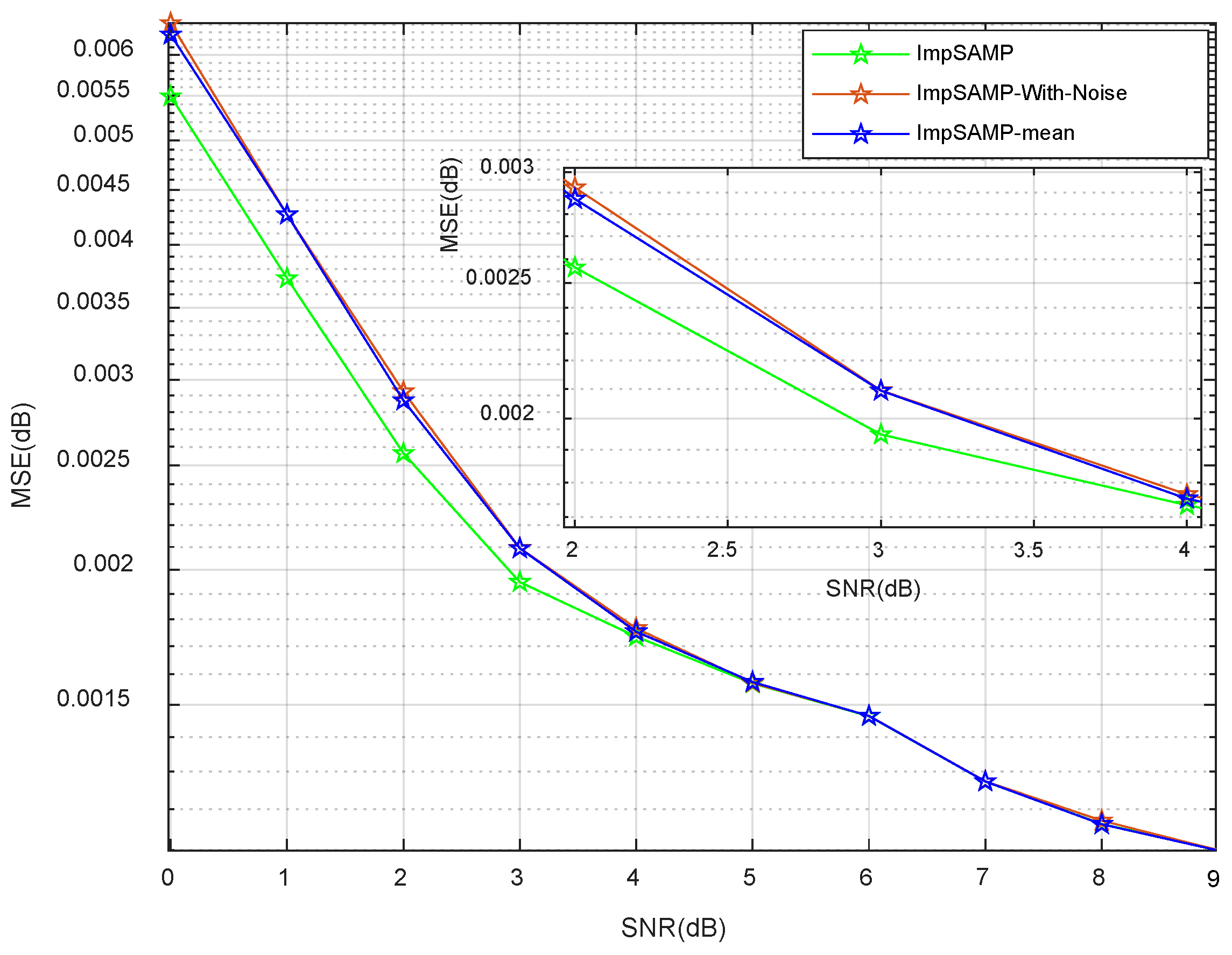
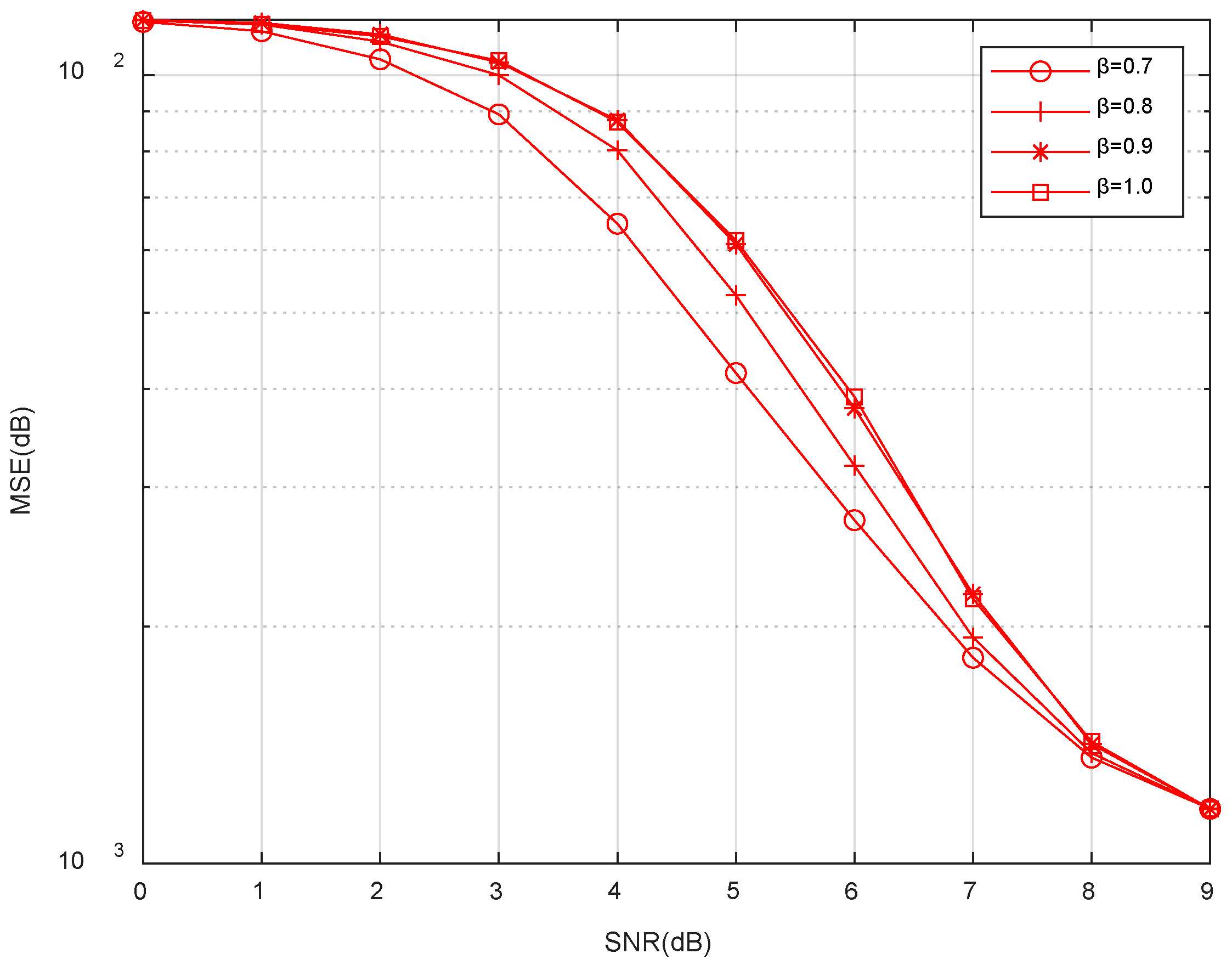

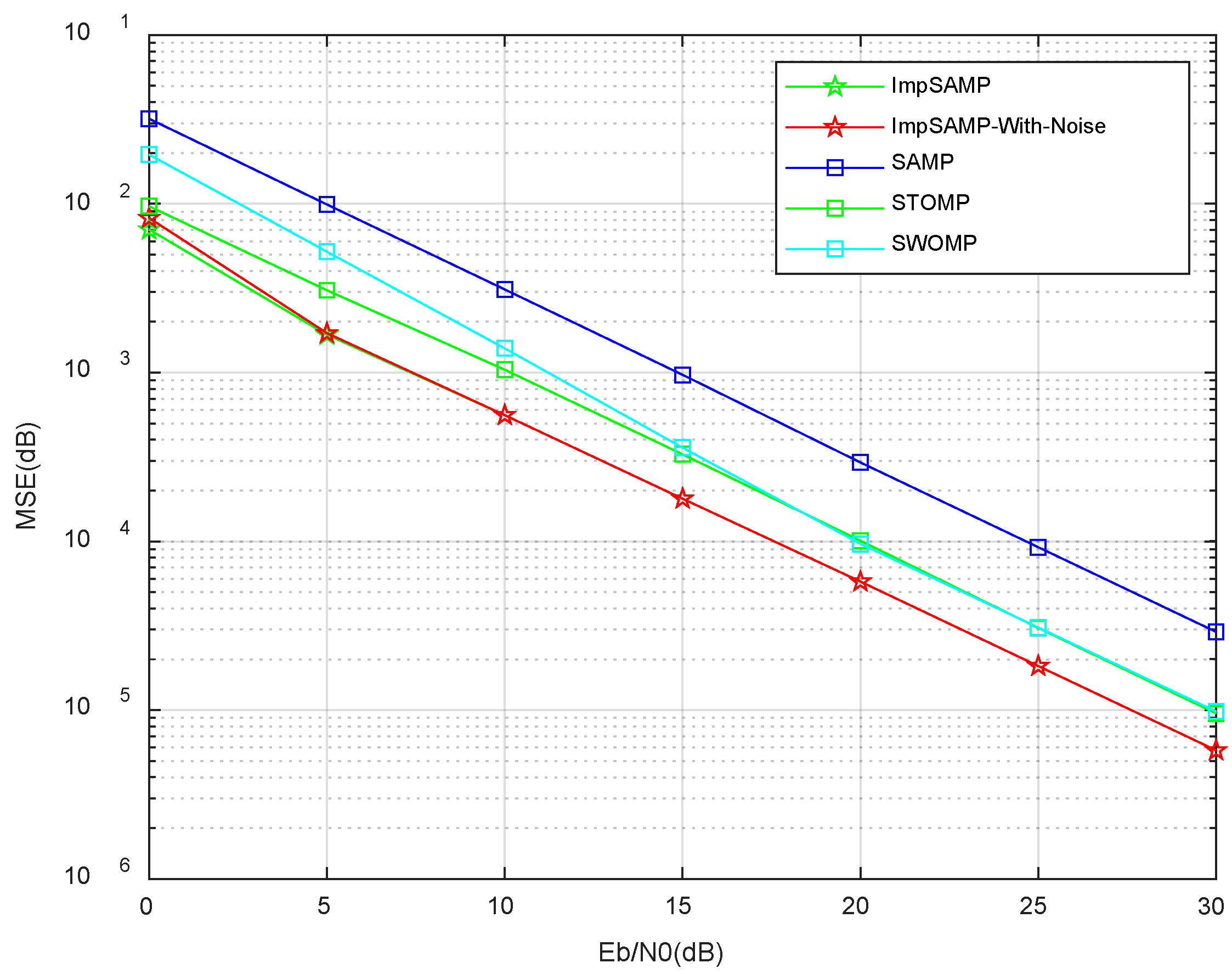
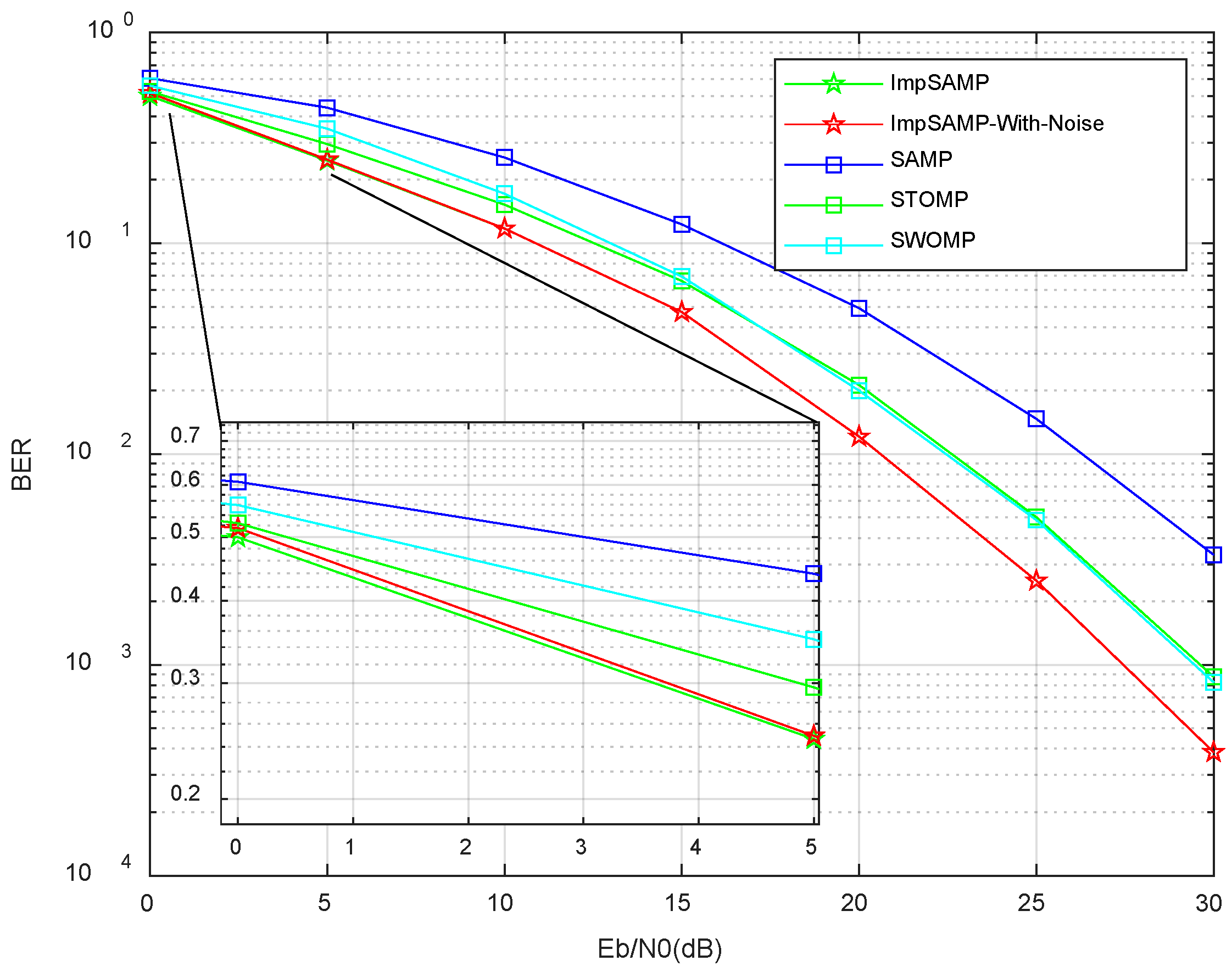

| Parameters | Symbol | Value |
|---|---|---|
| Channel type | — | Rayleigh fading channel |
| Observation vector length | M | 100 |
| Sparse signal length | N | 256 |
| Signal sparsity | Q | 15 |
| Initialize the step size | 4 | |
| Energy threshold coefficient | 0.7 | |
| Fuzzy threshold coefficient | 0.2 |
Disclaimer/Publisher’s Note: The statements, opinions and data contained in all publications are solely those of the individual author(s) and contributor(s) and not of MDPI and/or the editor(s). MDPI and/or the editor(s) disclaim responsibility for any injury to people or property resulting from any ideas, methods, instructions or products referred to in the content. |
© 2023 by the authors. Licensee MDPI, Basel, Switzerland. This article is an open access article distributed under the terms and conditions of the Creative Commons Attribution (CC BY) license (https://creativecommons.org/licenses/by/4.0/).
Share and Cite
Hu, H.; Zhao, X.; Chen, S.; Huang, T. An Improved SAMP Algorithm for Sparse Channel Estimation in OFDM System. Sensors 2023, 23, 6668. https://doi.org/10.3390/s23156668
Hu H, Zhao X, Chen S, Huang T. An Improved SAMP Algorithm for Sparse Channel Estimation in OFDM System. Sensors. 2023; 23(15):6668. https://doi.org/10.3390/s23156668
Chicago/Turabian StyleHu, Hao, Xu Zhao, Shiyong Chen, and Tiancong Huang. 2023. "An Improved SAMP Algorithm for Sparse Channel Estimation in OFDM System" Sensors 23, no. 15: 6668. https://doi.org/10.3390/s23156668
APA StyleHu, H., Zhao, X., Chen, S., & Huang, T. (2023). An Improved SAMP Algorithm for Sparse Channel Estimation in OFDM System. Sensors, 23(15), 6668. https://doi.org/10.3390/s23156668








